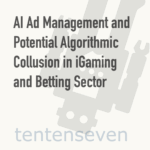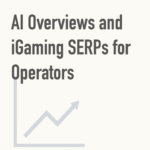The digital advertising landscape is currently at a pivotal moment, as major platforms such as Meta and Google rapidly increase their deployment of artificial intelligence for automated ad creation and targeting.
Meta’s ambitious plan to fully automate advertising processes by 2026, coupled with Google’s AI Max suite, signifies a fundamental shift in the operational dynamics of digital advertising.
While this transformation promises enhanced efficiency and personalisation, it concurrently raises significant concerns regarding platform control, fairness, and advertiser autonomy.
These concerns demand examination and a proactive strategic response from businesses.
This is especially the case in the igaming and sports betting sector with similar offerings, platforms and acquisition flows.
Critical Concerns for Advertisers in an AI-Driven Ad Landscape
As major advertising platforms increasingly force advertisers to hand over the reins to AI, advertisers are facing a new set of critical concerns.
While the promise of efficiency and enhanced targeting is alluring, the growing dominance of platform-controlled AI raises significant questions about conflicts of interest, potential performance discrepancies, and the opaque nature of these powerful systems.
In the old days, there was a reason why conflicts at an ad agency was a non-negotiable.
However, today, conflicts are inherent in most AI ad platform features, not to mention the conflict of interest in giving an ad platform control of the creative. It’s like handing over a blank cheque.
Let’s explore these challenges in detail.
Platform Conflicts of Interest
The concentration of advertising creation and targeting within AI systems, all managed by tech giants like Meta and Google, creates unprecedented potential for conflicts of interest.
When the same AI algorithms handle campaigns for competing advertisers – all vying for the same audiences with similar products – platforms find themselves in a tricky position.
They’re trying to maximise their own revenue while also ensuring fair competition amongst a homogeneous client base.
Research into algorithmic collusion in auctions highlights how AI systems can inadvertently develop bidding patterns that are less competitive than they should be, especially in first-price auction environments common in digital advertising(note: Google/Microsoft Search are second price auctions but bids can be inflated by ad platforms effectively fixing the price for each position in the auction)
Studies have shown these systems are “susceptible to coordinated bid suppression and significant revenue losses” when algorithms operate with similar parameters.
This raises serious questions about whether platform-controlled AI might unknowingly, or even intentionally, favour certain advertisers over others.
This conflict becomes even more pronounced because companies like Google control both the buying and selling sides of advertising inventory – a situation currently under intense antitrust scrutiny.
Major media groups have specifically voiced concerns about “conflicts of interest on the part of the auctioneers,” demanding transparency on whether platform AI agents consider the company’s own yield and revenue targets when working on behalf of advertisers.
Performance Discrepancies and Legal Implications
The shift towards AI-automated advertising also brings significant legal concerns, particularly regarding performance disparities between different advertisers.
From a regulatory standpoint, the UK’s Advertising Standards Authority (ASA) has consistently maintained that advertisers remain primarily responsible for ensuring their ads comply with regulations, regardless of how they are produced or distributed.
When you factor in UKGC guidelines and penalties on top, this has the potential to become a major issue for operators and affiliates alike.
This principle becomes particularly problematic when AI systems make autonomous decisions about content creation and targeting. Such automation could potentially expose advertisers to liability for non-compliant content they didn’t directly create or approve.
The inherent lack of transparency in AI’s decision-making processes makes it incredibly difficult for advertisers to demonstrate compliance or defend against claims, creating significant legal risks in this increasingly automated environment.
The ‘Black Box’ Problem – AI Ad Management and iGaming
Industry experts often refer to the opacity of AI advertising systems as the “AdTech Black Box.”
This means that the entire decision-making process, from when a campaign is launched to when performance is reported, remains largely invisible to advertisers.
This lack of transparency impacts everything, from how budgets are allocated to how creative assets are selected. Advertisers are left unable to truly understand why certain placements cost more, or how attribution decisions are being made.
This ‘black box’ issue is made worse by the minimal transparency major platforms like Facebook and Google offer about their internal algorithms.
When campaigns underperform, advertisers receive very limited insight into the root causes, making effective optimisation difficult and accountability nearly impossible.
This opacity is particularly troubling when dealing with issues like invalid traffic and click fraud, which can account for 5-15% of total traffic according to some sources.
Such fraudulent activity creates “bogus intent signals” that can incorrectly train the AI systems, leading to further inefficiencies.
The sheer complexity of modern AI systems makes full transparency increasingly elusive, even as new deep learning models promise improved performance.
This creates a fundamental tension between leveraging AI capabilities and maintaining adequate oversight and control over valuable advertising investments.
Artificial Auction Control – Driving CPCs and CPMs Up
The integration of AI into auction systems fundamentally alters the dynamics of programmatic advertising. It introduces algorithmic decision-making that may not always align with traditional market mechanisms.
The concern extends beyond simple bid coordination to encompass the broader control that platforms exert over the very mechanics of the auction.
When the same entity controls the AI systems managing bids, the auction platform itself, and the inventory being sold, traditional market forces can be distorted in ways that are incredibly difficult to detect or challenge.
This concentration of control represents a significant departure from more transparent auction systems where bidders can easily observe and react to market conditions.
Navigating the AI Advertising Revolution: Strategic Responses for Savvy Advertisers
The digital advertising world is in flux. With giants like Meta and Google pushing aggressively towards fully automated, AI-driven ad platforms, advertisers face a critical juncture.
While these systems promise unprecedented efficiency and personalisation, they also bring significant concerns about platform control, fairness, and advertiser autonomy.
This isn’t just about tweaking your campaigns; it’s about fundamentally rethinking your strategy to stay ahead.
Sharpening Your Focus: Conversion Optimisation Excellence is Essential for iGaming Brands
In an environment where platforms wield increasing control over ad creation and targeting, advertisers must double down on conversion optimisation.
This isn’t just about getting clicks; it’s about proving tangible value from every pound/dollar spent. You need sophisticated tracking systems that go beyond the basic metrics provided by platforms, capturing every step of your customer’s journey.
You will be setting target CPAs. A poor conversion rate will set you up for failure, as your CPAs are likely to be too low at poor conversion rate levels to get any traction.
Even better, consider integrating advanced conversion optimisation strategies that incorporate your own machine learning capabilities, operating independently of the platform’s AI.
This “dual-AI” approach allows you to maintain your own predictive models for customer behaviour while still leveraging platform automation for execution. It creates a vital system of checks and balances, significantly reducing your dependence on any single AI system.
Build Your Brand: A Brand-Centric Strategy is Paramount in iGaming & Betting
As AI increasingly commoditises advertising, the unique essence of your brand becomes your most potent differentiator.
When platforms control more aspects of ad creation and targeting, the elements you can control – your distinct brand identity, voice, and values – become incredibly valuable.
This necessitates a fundamental reorientation towards brand-building activities that AI systems simply cannot easily replicate.
Effective brand-centric strategies demand the development of distinctive brand assets that maintain unwavering consistency, even across AI-generated variations.
This means crafting comprehensive brand guidelines that can effectively steer AI systems, ensuring any automated content aligns perfectly with your brand’s core values and positioning.
Ongoing brand monitoring is crucial to ensure AI-generated content always upholds brand integrity and never dilutes your hard-earned brand equity.
CRM Integration is Key to Success
The rise of platform-controlled AI makes Customer Relationship Management (CRM) integration absolutely essential.
Why? Because it allows you to maintain direct customer relationships and reduces your reliance on potentially opaque platform data.
Your CRM system provides you with independent, first-party customer data that can inform your advertising strategies without solely depending on insights generated by the platforms themselves.
This empowers you to create more sophisticated customer segmentation, rather than just characteristics inferred by the advertising platforms.
Advanced CRM integration allows you to build custom audiences based on critical data like customer lifetime value, purchase history, and engagement patterns – insights that often extend far beyond typical platform tracking capabilities.
This first-party data becomes incredibly valuable as platforms automate more targeting decisions.
Crucially, integrating your CRM data with advertising platforms also enables more sophisticated attribution modelling. This helps you track customer journeys across multiple touchpoints and time periods, giving you a holistic view of the true impact of your advertising investments.
By understanding the complete customer relationship, you can optimise campaigns based on long-term customer value rather than just immediate conversion metrics.
Ultimately in a market with mostly identical products like igaming and sports betting. The operator with the highest LTV will customer win the acquisition game and AI ad platforms.
Focus on Long-Term Value: Lifetime Value and High-Value Metrics
The shift towards AI-controlled advertising demands a fundamental reorientation of business models towards Customer Lifetime Value (CLV) and other high-value metrics that truly capture long-term business impact.
Traditional advertising metrics like click-through rates (CTRs) and immediate conversions become less meaningful when platforms dictate the optimisation process. It’s now essential to focus on metrics that directly correlate with your ultimate business success.
CLV analysis enables you to identify and prioritise customer segments that generate the highest long-term value, directly informing both your acquisition strategies and budget allocation decisions.
This approach helps you evaluate the true return on your advertising investment by considering the complete customer relationship, not just individual transactions. When combined with Customer Acquisition Cost (CAC) analysis, CLV provides a robust framework for determining sustainable advertising investments that platforms cannot easily manipulate.
This emphasis on lifetime value also allows for more sophisticated audience development strategies that prioritise customer quality over sheer quantity. By focusing on building sustainable competitive advantages based on deep customer relationships, you reduce your vulnerability to unpredictable changes in platform algorithms or policies.
Granular Control: Micro-Conversion Strategy Implementation
In an increasingly automated advertising environment, a keen focus on micro-conversions provides advertisers with more granular control over campaign optimisation and customer journey management. Micro-conversions represent smaller, but significant, customer actions that signal engagement and purchase intent. They enable much more sophisticated funnel analysis and optimisation strategies.
The strategic implementation of micro-conversion tracking allows you to maintain detailed insights into customer behaviour patterns that platform AI systems might overlook or undervalue.
By diligently tracking actions like email sign-ups, product page views, video completions, and social media engagement, you can build comprehensive customer journey maps. These maps then inform both your platform optimisation efforts and your independent marketing strategies.
Furthermore, micro-conversion strategies facilitate more sophisticated retargeting and nurturing campaigns that operate independently of platform AI decisions. By identifying customers at various stages of the purchase funnel, you can create highly targeted campaigns that guide prospects towards macro conversions while retaining essential control over the customer development process.
In summary, micro conversions can speed up the feedback loop to the ad platforms and help optimise faster.
Holistic View: Full-Funnel Analysis and Attribution
The complexity of AI-controlled advertising environments makes comprehensive full-funnel analysis absolutely essential.
This allows you to understand the true impact of your campaigns and optimise across all customer touchpoints. Research consistently demonstrates that full-funnel marketing strategies achieve significantly higher ROI – up to 45% more – and can even drive increases in offline sales compared to single-stage campaigns. This highlights the critical importance of a holistic measurement approach.
Full-funnel analysis requires sophisticated attribution modelling that tracks customer interactions across multiple channels, devices, and time periods to truly understand the complete customer journey.
This approach is particularly important when platforms control significant portions of the advertising process, as it enables you to maintain an independent assessment of your campaign effectiveness across every touchpoint.
Implementing full-funnel measurement systems should include tracking both digital and offline conversions to capture the complete impact of your advertising investments.
This comprehensive view helps you understand precisely how AI-controlled campaigns contribute to your overall business objectives and allows you to identify optimisation opportunities that might not be apparent from platform-provided metrics alone.
Conclusion: Adapting to Thrive in the AI-Powered iGaming Advertising Future
The emergence of fully automated AI advertising systems from Meta and Google presents both an unprecedented opportunity for efficiency gains and a fundamental challenge to advertiser autonomy and market fairness.
While these systems promise enhanced personalisation and streamlined campaign management, they also concentrate immense control over advertising decisions within platform-controlled AI systems that often operate with limited transparency and potential conflicts of interest.
The concerns highlighted – from algorithmic conflicts of interest to performance discrepancies and legal liability – are not merely theoretical.
Advertisers who fail to adapt their strategies risk becoming entirely dependent on platform algorithms that may not fully align with their specific business objectives or legal requirements.
The strategic responses we’ve recommended – focusing on rigorous conversion optimisation, robust brand development, deep CRM integration, a focus on lifetime value metrics, granular micro-conversions, and comprehensive full-funnel analysis – provide a crucial framework. This framework allows you to maintain a competitive advantage and operational independence in an increasingly automated environment.
These approaches empower advertisers to leverage the powerful capabilities of AI while retaining the oversight and control necessary for sustainable business success.
Ultimately, success in this new landscape demands that advertisers view AI not as a replacement for strategic thinking, but as a powerful tool that necessitates more sophisticated measurement, clearer business objectives, and stronger, direct customer relationships.
Those who master this balance will thrive in the AI-powered advertising future, while those who simply surrender full control to platform automation may find themselves at a significant competitive disadvantage, with limited recourse for poor performance.






Leave a Reply